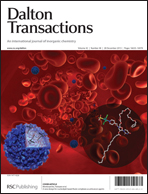Kinetic and mechanistic studies on reactions of diruthenium(ii,iii) with biologically relevant reducing agents†
Abstract
Diruthenium(II,III)-tetracarboxylates have shown promising anticancer properties as metallotherapeutics. On the basis of the role that bio-reducing agents may play on the mode of action of ruthenium-based anticancer drugs, we performed detailed kinetic studies on the reaction of ascorbic acid and glutathione with the [Ru2(RCOO)4]+ paddlewheel framework by using the non-drug, diaqua complex ion [Ru2(CH3COO)4(H2O)2]+. In the presence of the reducing agents, the diaqua-Ru2 species first undergo a ligand substitution reaction by which the axially-coordinated water is displaced by the reducing agent. In both cases, this reaction is followed by an intra-molecular electron transfer process during which the metal–metal center is reduced from Ru25+ to Ru24+ and the reducing agent is oxidized. Product analyses were performed with the application of ESI-MS and 1H-NMR techniques. Rate and activation parameters are reported for the different reaction steps.


 Please wait while we load your content...
Please wait while we load your content...